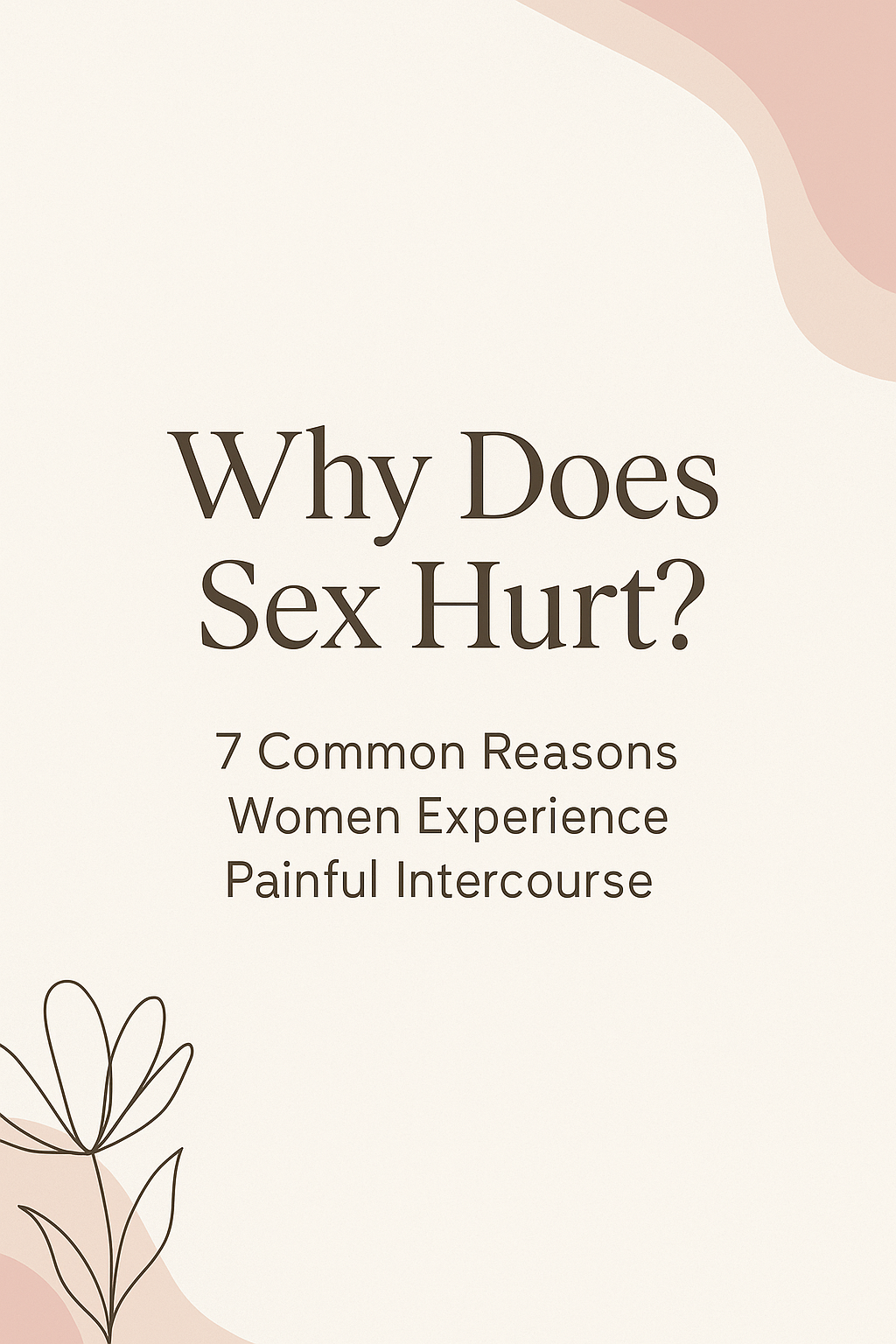
Why Does Sex Hurt? 7 Common Reasons Women Experience Painful Intercourse
Share
If you’ve ever asked yourself, “Why does sex hurt?”, you’re not alone — and you’re not broken. Painful sex (the clinical term is dyspareunia) is common and often treatable once you understand the cause. Studies estimate that 10–20% of women experience dyspareunia, and it can affect emotional well-being and relationships if left unaddressed.
Below are the most frequent, evidence-based reasons sex may be painful — plus next steps you can take today.
1) Vaginal Dryness and Genitourinary Syndrome of Menopause (GSM)
Low estrogen (common in perimenopause/menopause or while breastfeeding) thins and dries vaginal tissues, which can make penetration feel burning or tight. Local treatments like topical vaginal estrogen are effective for many and are considered first-line for GSM-related dyspareunia.
Try now: quality lubricant during intimacy; discuss moisturizers or local estrogen with a clinician if dryness is persistent.
2) Pelvic Floor Muscle Tension (Overactivity)
When pelvic floor muscles are too tight (sometimes from stress, anxiety, guarding after pain, or past experiences), penetration can feel sharp, burning, or “blocked.” Multiple clinical studies — including randomized trials — show pelvic floor physical therapy (PFPT) and biofeedback can significantly reduce sexual pain and improve function.
Try now: gentle diaphragmatic breathing, extended foreplay, and consult a pelvic floor PT for assessment and tailored relaxation training.
3) Infections or Inflammation (Yeast, BV, UTI, Vaginitis)
Active infections and inflammatory conditions sensitize tissues and can make any friction painful. Treating the underlying cause usually resolves the pain. If symptoms linger after treatment, follow-up is important to rule out other contributors.
4) Vulvar Pain Disorders (e.g., Provoked Vestibulodynia)
Some women develop vulvodynia/vestibulodynia, where the vulvar or vestibular tissue is painful to touch without another clear cause. International societies standardized terminology in 2015 to improve diagnosis and care, acknowledging multifactorial drivers (neurologic, inflammatory, muscular, hormonal).
Good to know: multimodal care (pelvic floor therapy, topical medications, behavioral strategies) is often most effective.
5) Endometriosis and Deep Pelvic Conditions
Pain with deep penetration can signal endometriosis, fibroids, ovarian cysts, or pelvic organ prolapse. These conditions benefit from medical evaluation — and tailored treatment can meaningfully reduce dyspareunia.
6) Postpartum Changes
After birth, hormonal shifts, healing tissues, and (sometimes) scarring can make sex uncomfortable for a period of time. A large meta-analysis of 22 studies (11,457 women) found postpartum dyspareunia prevalence around 35%, with rates gradually improving by 6–12 months. If pain persists, seek support and assessment.
7) Arousal, Stress, and the Mind–Body Link
Rushed or uncomfortable encounters, stress, and fear of pain can increase muscle tension and reduce natural lubrication — creating a cycle where the body braces and sex hurts more. Addressing arousal, safety, and communication (sometimes with a therapist) can be pivotal. Professional guidance groups this within genito-pelvic pain/penetration disorder in diagnostic frameworks.
What Actually Helps? (Backed by Evidence)
-
Pelvic Floor Physical Therapy: RCTs and systematic reviews support PFPT (often with biofeedback) for reducing dyspareunia tied to muscle overactivity.
-
Lubricants & Moisturizers: First-line for dryness; choose body-safe, non-irritating options.
-
Local Vaginal Estrogen (for GSM): Improves tissue health and comfort; discuss with your clinician, especially if you’re postmenopausal.
-
Gentle Dilator or Trainer Programs: Evidence is mixed and condition-specific, but structured, low-dose movement-based protocols can help some women retrain pelvic floor relaxation; best used under guidance.
-
Medical Management of Underlying Conditions: Treating endometriosis, infections, or dermatologic conditions often reduces pain.
Always seek personalized medical advice if your pain is persistent, severe, or new. A clinician can screen for conditions that need targeted treatment.
A Private, Gentle Place to Start
If you want a supportive companion you can read discreetly at home, our beautifully designed digital guide brings together clear explanations, step-by-step relaxation practices, affirmations, and printable worksheets to help you move from fear to confidence — at your own pace.
Inside, you’ll find:
- Clear explanations of common causes.
- Gentle exercises and emotional support tools.
- Affirmations and printable worksheets to guide your journey.
👉 Download Overcoming Painful Sex and begin your healing journey today.
References & Trusted Resources
-
Mayo Clinic. Painful intercourse (dyspareunia): symptoms, diagnosis & treatment. Updated 2024.
-
American Academy of Family Physicians. Dyspareunia in Women (clinical review, 2021).
-
Cleveland Clinic. Vaginal Atrophy (GSM): symptoms & treatment.
-
Cleveland Clinic Journal of Medicine. Genitourinary syndrome of menopause: overview and management (2018).
-
ISSVD/ISSWSH/IPPS. 2015 consensus terminology for persistent vulvar pain and vulvodynia.
-
Ghaderi et al. Pelvic floor rehabilitation in women with dyspareunia — randomized clinical trial (2019).
-
Fernández-Pérez et al. Systematic review: effectiveness of physical therapy interventions in dyspareunia (2023).
-
Banaei et al. Prevalence of postpartum dyspareunia: systematic review & meta-analysis (2021).
Why Talking About Painful Sex Matters
Ignoring painful sex doesn’t make it go away. It can affect self-esteem, relationships, and overall well-being. But understanding the reasons is the first step toward change.
👉 Download your copy today instantly and take the first step toward pain-free intimacy.




